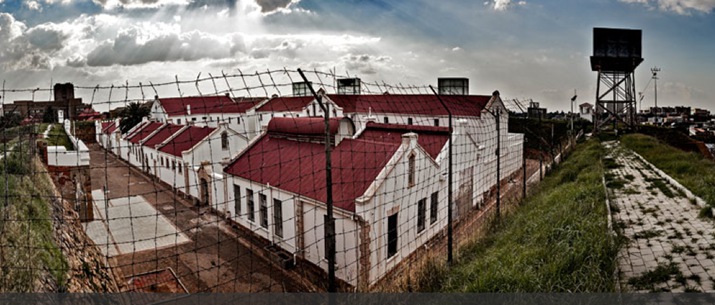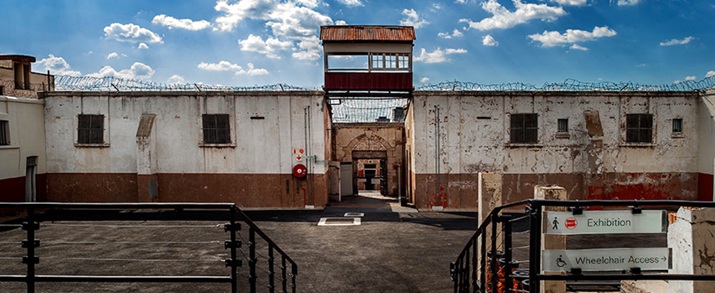|
|||||||||||
|
|
| You Be the Judge |
| Walking through South Africa's complex political past at Constitutional Hill |
| By Jo Kromberg |
 |
|
Constitutional Hill |
The heat beats down on me in the desolate, eerie courtyard of this once prison-turned defence post-turned prison again on a hot day in early summer.
I am alone and I can feel the ghosts of thousands of bound and incarcerated souls in this place over the past century. I finally locate my host, the friendly Lwazi Siyaka, Marketing and Venue Hire Manager at Constitution Hill who introduces me to Pious, my guide through the annals of a sordid and disturbing time and place in our country’s history. The first part of the tour is an orientation video, which provides the context and background of this historical site.
Pious then takes me on a tour of the buildings and tells me that all these buildings together were known as the Fort, a place that was notorious for its harsh treatment of prisoners who ranged from common criminals to hundreds of thousands of ordinary men and women who contravened colonial and apartheid legislation such as hut tax laws, beer brewing laws, pass laws and the Group Areas act. Many political prisoners were also incarcerated at the Fort. Boer military leaders like General De Wet were imprisoned during the South African war 1899-1902. In 1906 and 1913 Indian passive resisters (including Mahatma Gandhi) were incarcerated here. It is strange and bitterly ironic that this place was the ultimate leveller in terms of the cultures of inmates over the century.
Pious describes the conditions in the prisons in chilling detail and the solitary confinement cells have been virtually exactly preserved as they were. You can almost hear the screams and smell the despair inside these cells. If you were unfortunate enough to find yourself in solitary confinement, you would be kept in a dark 2 X 4 metre cell for 23 out of 24 hours and only given water and rice to eat for weeks on end. Scenes from the movies Midnight Express and the Count of Monte Christi come to mind as I tentatively wonder into the dark hole of one of the cells and fear and claustrophobia grip me. I think of what men like Mandela and Ghandi endured here and what they subsequently achieved and the strength of the human spirit confounds me in that moment yet again. Pious continues by telling me that countless activists against the repressive regime of the then new apartheid state passed through the entrance of the Old Fort: many involved in the 1952 Defiance Campaign, the treason trialists of 1956 (including Nelson Mandela), and those imprisoned after various waves of resistance. In every compound that we visit, there are plaques with quotes by prisoners and warders and videos of ex-prisoners talking about their ordeal. The experience is made visceral and chillingly captivating through their voices.
The strangest of all is that I am strolling through living, modern history here.
 |
|
Political activists like Nelson Mandela and Mahatma Ghandi passed through these hallways |
The late 19th Century Old Fort was declared a National Monument in 1964 although it continued as a functioning prison until 1987, after which the buildings and the site as a whole suffered from neglect and vandalism.
It is a true testament of South Africa’s resilience and character that this site was then chosen as the site for the new Constitutional Court in the mid-1990s. The"Con Court" is the last stop on our tour and its design and symbolism is truly breath-taking.
The building has won numerous global design awards and houses the biggest law library in the Southern Hemisphere. The South African Constitution begins with the words: "We, the people..." and the entire building is designed to reflect the sacredness and importance of every individual in our country in the most amazing detail. The chamber itself is spellbinding. We have eleven sitting Con Court judges to represent every culture in our country and the public gallery seats are situated either at eye level of the judges seats or higher-- making the point that they ultimately serve the people. The glass panels reflect the transparency of the Con Court and the bricks in the walls are all exposed; bricks that used to enclose and enslave the prisoners next door.
I leave Constitutional Hill with a newfound respect and pride in my country and what we have achieved. Freedom’s another word for everything to gain, actually Janis...
Additional source: http://www.constitutionhill.org.za/about-us/political-events/
WHERE IS CONSTITUTION HILL?
Constitution Hill is a city precinct, anchored by the South African Constitutional Court --the highest court in the country. Situated on a hill overlooking the bustling Johannesburg city and the fostered suburbs, Constitution Hill provides a unique perspective of Johannesburg and its rich history. The site is home to the Women’s Gaol museum, Number Four Museum, and Old Fort Museum.
(source: http://www.constitutionhill.org.za/about-us/political-events/)
Contact details:
Visitor Centre
PO Box 31005
Braamfontein
2017
Tel: +27 11 381 3100
Fax: +27 11 381 3108
Email: info@constitutionhill.org.za
Website: http://www.constitutionhill.org.za
GPS Co-ordinates:-26.190217,28.041916
Prison cells that held activists against the former apartheid regime

Air China now flies to South Africa direct
Outbound flights operates on Tuesdays, Thursdays and Sundays, with return services from Johannesburg offered on Mondays, Wednesdays and Fridays.
Flights will departs from Beijing at 23:15 Beijing time, and arrive in Johannesburg at 07:35 local time on the following day. The inbound flight departs from Johannesburg at 11:50 local time and arrives in Beijing at 07:30 Beijing time.
Air China said it would operate a Boeing 777-300ER on its first direct route to Africa and the first direct air link offered by a Chinese carrier between Mainland China and South Africa.
Photos: courtesy www.constitutionhill.org.za
|
||||||||||||
|
|||
| Copyright ChinAfrica All right reserved 京ICP备08005356号 |